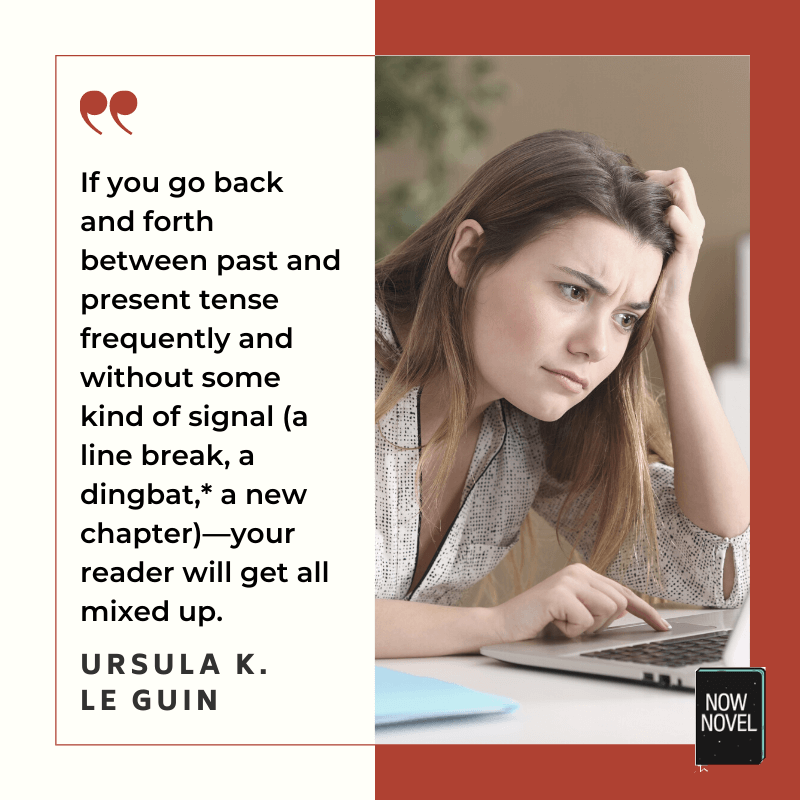‘What exercises can I do to improve my writing craft?’ Writing often and reading a lot are common answers given to this question. Writing exercises targeting specific aspects of craft help too. Dip into these fun, practical writing workouts on using tenses correctly:
General tips on tense use:
Knowing how to use verb tenses is key to telling a great story.
Switching between tenses should be intentional, without confusing the reader.
‘I went to the store this morning. I am buying milk when I realised I will not have had bread’ is confusing. Why? because we can’t easily pinpoint when which event happens.
Ursula K. Le Guin puts this humorously in her must-read writing manual Steering the Craft:
I could almost state this as a rule, but I won’t, because good and careful writers will blow all Rules of Writing into bits. So I state it as a High Probability.
Ursula K. Le Guin in ‘6: verbs: person and tense’ in Steering the Craft: A 21st century guide to sailing the sea of story (1998), p.
It is highly probable that if you keep changing the tense of your narrative, if you go back and forth between past and present tense frequently and without some kind of signal (a line break, a dingbat,* a new chapter)—your reader will get all mixed up and will not know what happened before what and what’s happening after what and when we are, or were, at the moment.
10 exercises for practicing tense:
- Switch between tenses with intent
- Mix present actions with memories
- Change verbs and persons of verbs
- Use future perfect tense
- String together present participles
- Recognize tense inconsistency
- Master subjunctive mood
- Play with the infinitive
- Use present perfect continuous tense
- Change irregular verbs
These grammatical tense terms might seem confusing, but read on for explanations and exercises to help you understand them on a craft level:
1. Switch between tenses with intent
Write a 500-word flash fiction in which a character describes events leading up to a surprising encounter at the grocery store.
Use past perfect tense for prior events, and switch to present when they renact the encounter itself.
(Example of a switching point: ‘…so I had gone to the wine aisle. Picture this: [words signalling switching tense] I’m standing there when…’)
2. Mix present actions with memories
Often there are two simultaneously narrated time-periods in a scene. Something a character is doing now, and past events they’re remembering.
Le Guin calls this exercise ‘The Old Woman’. Her instructions:
The subject is this: An old woman is busy doing something—washing
Le Guin, Steering the Craft, pp. 50-51.
the dishes, or gardening, or editing a PhD dissertation in mathematics,
whatever you like—as she thinks about an event that happened in her
youth.
You’re going to intercut between the two times. “Now” is where she
is and what she’s doing; “then” is her memory of something that
happened when she was young. Your narration will move back and forth
between “now” and “then.”

Try even more writing exercises for creating characters for extra practice.
3. Change verbs and persons of verbs
Singular persons (‘I’, ‘you’, ‘she/he/it’) and plural persons (‘we’, ‘they’, ‘you’ plural) take different verbs.
For example we say ‘I go’ for present first person, but ‘she goes’ (not ‘she go’, unless perhaps writing a local dialect of English where non-standard grammar gives regional quality).
Rewrite this altered passage by Barbara Kingsolver in second-person, present tense (‘A first child is your own best foot forward…’):
A first child was their own best foot forward, and how they did cheer those little feet as they struck out. They examined every turn of flesh for precocity, and crowed it to the world. But the last one: the baby who trailed her scent like a flag of surrender through their life when there would be no more coming after–oh, that was love by a different name.
Barbara Kingsolver, The Poisonwood Bible, edited.
[See the answer, the original quote, here – try not to cheat!]
4. Use future perfect tense
Some tenses, such as future perfect (‘I will have lived…’) we see and use less frequently than the simple ones.
For this writing exercise, describe a working class character’s grand future plans for when they achieve a major career goal (e.g. becoming vice president). Start with a pre-condition connected to setting (e.g. ‘I will have lived in the capital for 5 years’).
Use future perfect tense to describe at least 3 future conditions that will have been met (e.g. ‘I will have risen through the ranks to become the preferred candidate.’)
Find more future perfect tense examples here.
5. String together present participles
Present participles are ‘-ing’ verbs we use to describe unfolding actions.
For example, the bolded words in the following examples:
- Talking loudly to ensure the other elevator passengers could hear, she described the previous night’s passion to her colleague
- Running and laughing, the valedictorians threw their caps into the air
Chaining together multiple participles is a useful way to create a tumultuous sense of action.
For the fifth of these writing exercises, describe a stampede for the last remaining item (of your choice) at a big chain store on Black Friday.
Use at least 7 present participles to describe various shoppers’ behaviour.
6. Recognize tense inconsistency
Recognising when tenses have shifted incorrectly is key to being in control of when tenses change.
For this writing exercise, copy-paste this altered passage into your word processor and highlight the verbs that should change for correct tense:
So I know I am right not to settle, but it didn’t make me feel better as my friends pair off and I stay home on Friday night with a bottle of wine and made myself an extravagant meal and tell myself, This was perfect, as if I’m the one dating me. As I will go to endless rounds of parties and bar nights, perfumed and sprayed and hopeful, rotated myself around the room like some dubious dessert.
Gillian Flynn, Gone Girl, edited.
Rewrite in present continuous tense (compare to the original quote when you’re done). Bonus round: Rewrite the entire passage in simple past tense.
Note: Which verbs have to change, and which can stay the same?
7. Master subjunctive mood
‘Subjunctive mood’ is another more unusual grammar construction.
What exactly is ‘mood’ in grammar?
In grammar, mood refers to a verb form that shows the writer’s attitude toward the content of his or her words.
Margaret Stone, via study.com.
Subjunctive mood is a verb form we use to express a wish, command (AKA an imperative), hypothetical, or suggestion. For example:
- Timmy said, “If only I were a T-Rex!” (a wish)
- “It’s crucial that you pay attention, Timmy” (a command)
- If I were you, Timmy, I would be careful (a hypothetical)
- “Timmy, I suggest that you focus. You do not have tiny arms,” said his teacher (suggestion)
For this writing exercise, write a scene between a student and their teacher. Use at least one wish (‘If only I/you were…’), one command (‘It’s good/bad that you [present-tense verb]…’), one hypothetical and one suggestion.

8. Play with the infinitive
To be, or not to be, that is the question. Or, rather, ‘to get better at writing tense, or to bewilder your reader?’ Ideally, with practice, we’ll do the former!
The infinitive form of the verb is useful for expressing general, broad activity. For example:
- She loved to bake, even if her crusts were always inches thick and had a curiously charcoal hue
- To sing, to really belt it out, particularly when the neighbours were sleeping at 3 am, that was his passion.
- She wanted to dance but the dance floor was full of short jocks doing the raver fist pump… it seemed a good way to get a black eye
For this writing exercise on tense, write a paragraph describing a character’s personality using at least 5 infinitives. Pick one of the scenarios below. Choose between a:
- Lawyer who can’t help falling asleep in court
- Shop owner who loves to chase people who make them anxious from their store
- Restaurateur who loves to argue with customers
For example, you might begin ‘To stay awake was prudent, yet the judge’s gavel was his own private alarm clock.’
9. Use present perfect continuous tense
Present perfect continuous tense (also called present perfect progressive) is used when we describe actions that began in the past and continue in the present moment.
The positive takes the form has/have + ‘been’ + present participle. The negative uses ‘not’ (‘he has not been…’).
Examples:
- He has been sleeping in court since the trial began
- He has been eyeing a stick he keeps under the shop counter when a regular customer he finds obnoxious approaches
- She has not been arguing with the couple on their anniversary date about our tinned ravioli for the past forty minutes… at least I sure hope not
For this writing exercise, take the character you created in the previous section. Now describe a tense argument with someone who has accused them of bad conduct. (Remember to change the verb for second person if using dialogue. ‘He has been…’ becomes “You have been…”).
10. Change irregular verbs
Most verbs follow a specific pattern for changing forms.
For example, the past tense forms of verbs that simply take some variant of ‘-d’, ‘-ed’ or ‘-ted’:
- Bake – baked
- Steep – steeped
- Strut – strutted
Irregular verbs are those that do not follow the pattern. For example:
- go – went
- be – was/were
- grow – grew
For the last of these tense writing exercises, create a five-year-old’s written voice. Deliberately use incorrect verb conjugations to create a sense of non-mastery of language.
Begin with a phrase using an incorrect application of ‘the rule’ (e.g. that ‘bake’ becomes ‘baked’ in simple past tense) and have at least 5 more instances.
For example: ‘Deer Journal. Mom says I’ve growed so much…’
Need more writing prompts? Here are 50 categorized writing prompts to start.
Get more writing exercises in the form of easy, step-by-step prompts to develop your story.

